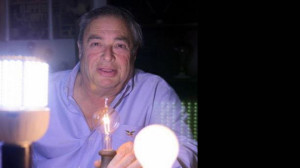The man who saved the lightbulb
FoxNews.com
A modern day Edison has a bright idea: a way to keep the incandescent bulb burning brightly, despite a government law set to go into effect New Year’s Day that effectively outlaws the most commonly used lightbulbs.
Most bulbs, that is. Not those made by lightbulb savior Larry Birnbaum.
“When the government decided to ban incandescent lightbulbs, they left a loophole in the law. An opening,” Birnbaum told FoxNews.com. “What that was was rough service.”
A “rough service” bulb is, in Birnbaum’s words, a bulb that can take a beating, one meant for industrial purposes — imagine a lightbulb on a subway car, built to survive the jostling and vibrations of the daily commute. But despite their intended use, they work just like normal bulbs: Consumers can buy them and screw them into any ordinary lamp socket.
The 2007 law forces manufacturers to improve the energy efficiency of ordinary bulbs dramatically: 40W bulbs must draw just 10.5W, and 60W bulbs 11W, and incandescents simply can’t do that.
'You’d be shocked how many people still want incandescents.'
– Larry Birnbaum, CEO of Newcandescent
But there are a variety of exceptions to that law for specialty lighting, including bulbs with unusual bases, others meant for special display purposes, and rough service bulbs. In 2010 Birnbaum applied for a permit to build them under the new specifications: Per the government, his bulbs needed seven filaments rather than two, a brass base, and 1 millimeter thicker glass, and the bulbs had to be filled with a special mixture of argon and krypton to improve their lifespan.
“They made it very difficult for everybody. I had to do three different samples at three different times until we finally got the approval, they were so critical,” he said. “I don’t blame them.”
His bulbs, called Newcandescents , began shipping in 2010 — made in America, at a plant outside of Indianapolis by around two dozen employees.
, began shipping in 2010 — made in America, at a plant outside of Indianapolis by around two dozen employees.
Demand has been remarkable, Birnbaum said. After a 2012 appearance on the Rush Limbaugh show, he received $100,000 worth of orders and enough traffic to crash the website.
“You’d be shocked how many people still want incandescents,” he told FoxNews.com. Many people are unsatisfied by those twisty compact fluorescent bulbs, he said, the main alternative to incandescent bulbs. “People don’t like the color, the fact that they don’t go on right away, the fact that they have mercury.”
CFLs also pose a health risk to some: A 2012 study from Stony Brook University found them much more likely to leak UV light compared to traditional fluorescent bulbs, causing damage to healthy human skin cells.
Newer LEDs are being hailed as the next great lighting tech, long life bulbs that sip power and ultimately should reduce electric bills substantially. But for now those bulbs are costly, despite dramatic price cuts over the past year. Home Depot sells — until supplies run out — a six pack of 60-Watt incandescents from GE for $4.67, or 78 cents apiece. A six-pack of 60-Watt LEDs from Cree sells for $77.82 — $12.97 each.
Newcandescents are available at a retail store in South Hackensack and in a variety of supermarket chains, including King Kullen, Gristedes, Pioneer and more. They’re also online: Bright Lights Inc ., a retailer that sells Newcandescent bulbs, lists a two pack for $2.88, or $1.44 apiece, CEO Paul Veen told FoxNews.com. His company caters to the south, distributing bulbs across Alabama, North Carolina, Tennessee and more.
., a retailer that sells Newcandescent bulbs, lists a two pack for $2.88, or $1.44 apiece, CEO Paul Veen told FoxNews.com. His company caters to the south, distributing bulbs across Alabama, North Carolina, Tennessee and more.
"Over in Alabama, they need our bulbs. They blow 120 volt bulbs all the time. Their power generation is a little higher,” Veen said.
Built to be sturdier, Newcandescent bulbs run on 130 volts rather than 120, meaning they last longer on the lower voltages, he said.
“If you’ve got a ceiling fixture and you don’t want to change the bulb every 10 months, use something that’s going to last.”
Other than their strength and durability, Newcandescents are just like the old incandescents, including the higher power consumption the new rules are meant to eliminate. But many people are willing to make that trade off.
“The incandescent color is very difficult to replicate — as far as in LEDs or CFLs, it’s virtually impossible,” Birnbaum said. “And unless you were born a few weeks ago, we’re all addicted to that color. “
Lighting run in the family for Birnbaum, a third-generation bulb man.
“My grandfather and Thomas Edison were very good friends,” he said, “He gave my grandfather an original Edison bulb — and it still works today.”
-
Commercial Lighting Tampa FL, 813-935-4448 / 813-514-1264 / 813-514-1265 / 813-932-1086 / 813-932-1547 / 813-935-8235
CommercialLightingTampa.com, 8139354448 / 8135141264 / 8135141265 / 8139321086 / 8139321547 / 8139358235
Call Us Today!
813-514-1266
813-935-4448
8135141266
8139354448

